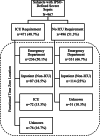Sociodemographic Factors are Associated with Care Delivery and Outcomes in Pediatric Severe Sepsis
- PMID: 38415020
- PMCID: PMC10896474
- DOI: 10.1097/CCE.0000000000001056
Sociodemographic Factors are Associated with Care Delivery and Outcomes in Pediatric Severe Sepsis
Abstract
Importance: Sepsis is a leading cause of morbidity and mortality in the United States and disparate outcomes exist between racial/ethnic groups despite improvements in sepsis management. These observed differences are often related to social determinants of health (SDoH). Little is known about the role of SDoH on outcomes in pediatric sepsis.
Objective: This study examined the differences in care delivery and outcomes in children with severe sepsis based on race/ethnicity and neighborhood context (as measured by the social vulnerability index).
Design setting and participants: This retrospective, cross-sectional study was completed in a quaternary care children's hospital. Patients 18 years old or younger who were admitted between May 1, 2018, and February 28, 2022, met the improving pediatric sepsis outcomes (IPSO) collaborative definition for severe sepsis. Composite measures of social vulnerability, care delivery, and clinical outcomes were stratified by race/ethnicity.
Main outcomes and measures: The primary outcome of interest was admission to the PICU. Secondary outcomes were sepsis recognition and early goal-directed therapy (EGDT).
Results: A total of 967 children met the criteria for IPSO-defined severe sepsis, of whom 53.4% were White/non-Hispanic. Nearly half of the cohort (48.7%) required PICU admission. There was no difference in illness severity at PICU admission by race (1.01 vs. 1.1, p = 0.18). Non-White race/Hispanic ethnicity was independently associated with PICU admission (odds ratio [OR] 1.35 [1.01-1.8], p = 0.04). Although social vulnerability was not independently associated with PICU admission (OR 0.95 [0.59-1.53], p = 0.83), non-White children were significantly more likely to reside in vulnerable neighborhoods (0.66 vs. 0.38, p < 0.001). Non-White race was associated with lower sepsis recognition (87.8% vs. 93.6%, p = 0.002) and less EGDT compliance (35.7% vs. 42.8%, p = 0.024).
Conclusions and relevance: Non-White race/ethnicity was independently associated with PICU admission. Differences in care delivery were also identified. Prospective studies are needed to further investigate these findings.
Copyright © 2024 The Authors. Published by Wolters Kluwer Health, Inc. on behalf of the Society of Critical Care Medicine.
Figures
References
-
- Hartman ME, Linde-Zwirble WT, Angus DC, et al. : Trends in the epidemiology of pediatric severe sepsis*. Pediatr Crit Care Med 2013; 14:686–693 - PubMed
LinkOut - more resources
Full Text Sources
Miscellaneous


